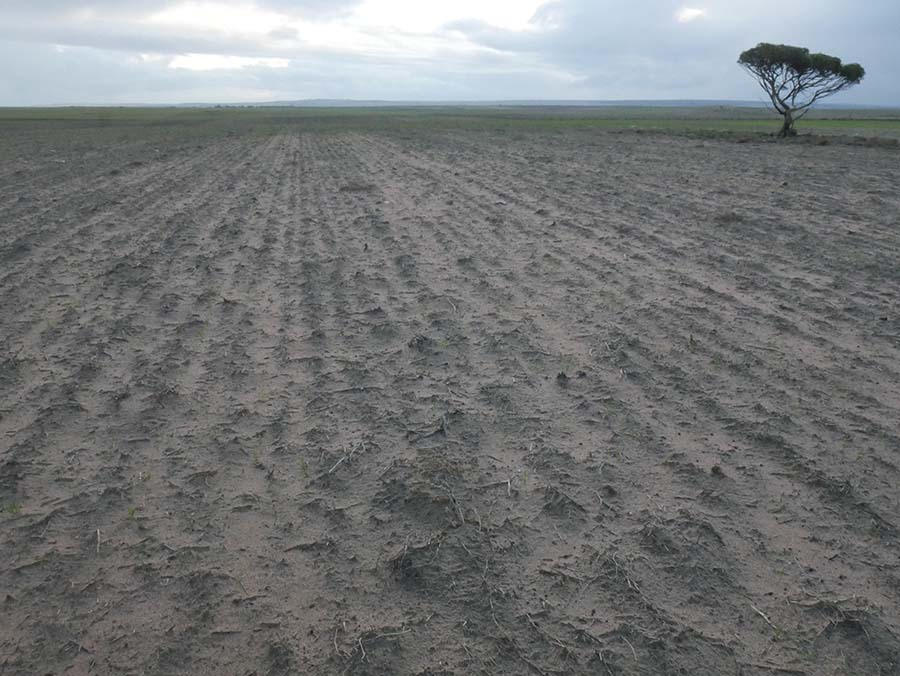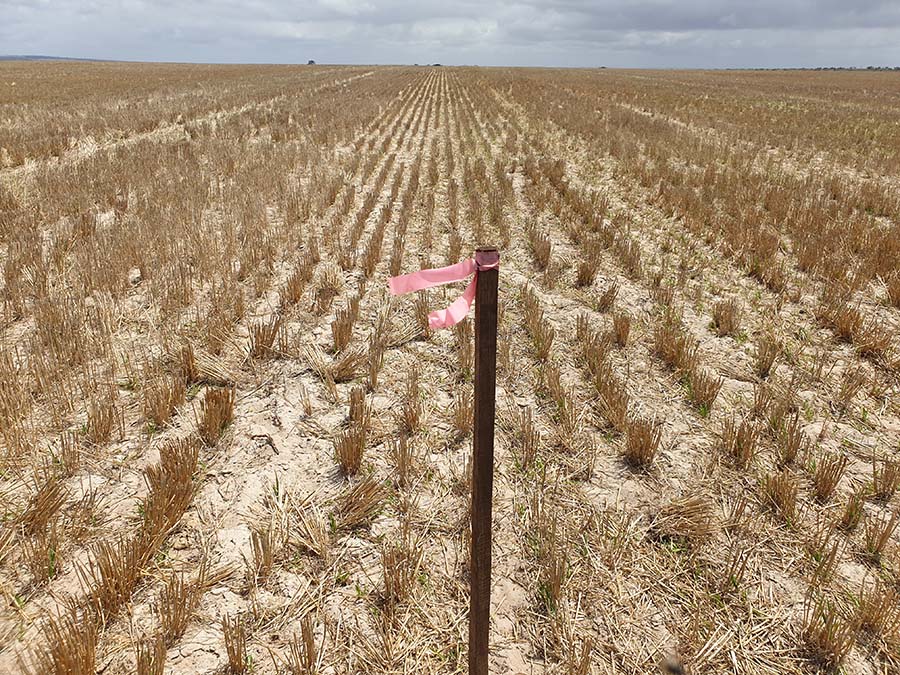Snapshot
Grower: Ed, Carolyn, Evan and Lauren Hunt
Location: Wharminda, Eyre Peninsula, South Australia
Farm size: 2,800 Ha
Enterprise: Cropping and grazing
Growing season rainfall: 320mm annual (230mm GSR)
Soil type: Deep, water repellent sandy rises and duplex sand over clays, to loamier flats, interspersed with shallow limestone reefs
Cropping program: 60% cereal and canola (moisture dependent) and 40% pasture (volunteer medic and sown vetch or vetch cereal mixes)
Seeding system: No-till farming, Flexicoil ST820 Bar with ProTrakker guidance for near row sowing on non-wetting sands.
Ed and Carolyn Hunt farm with their son, Evan and daughter-in-law Lauren near Wharminda on the Eyre Peninsula. They farm 2,800ha, with approximately 60% of their farm dedicated to cropping (mainly wheat and barley, but occasional canola when moisture allows) and 40% to pasture (good volunteer medic, sown vetch or vetch/cereal mixes and the occasional millet when opportunities arise).
They run a flock of 1,000 self-replacing ewes, achieving an approximate lambing percentage of 105% in most seasons. They also operate a feedlot with the capacity to house their entire flock if necessary.
The Hunt’s soils range from deep, water-repellent sandy rises and duplex sand over clays to loamier flats interspersed with shallow limestone reefs. Low and varied rainfall, combined with periods of strong wind, has increased vulnerability to erosion damage in their sandy soils.
In addition to grazing management on challenging sandy soils, the Hunt’s have undertaken significant clay delving with noticeable improvement to topsoil aggregation. In the future, they see the value in integrating farm-scale satellite imaging within their management plans as the technology develops to monitor cover.
The drought issue
The millennial drought (2002-2009) was challenging across the central Eyre Peninsula. Yet, it was a time when no-till farming systems were being rapidly adopted, with benefits during drought evident across farming systems within the area.
A run of above-average seasons was experienced from 2010-2016, resulting in strong production and good soil cover being achieved and maintained. However, 2017-2020 saw a combination of low rainfall, late breaks, poor finishes, and very strong winds during critical times that left significant cropping areas within the district bare and in need of repair.
While the Hunts acknowledge that multiple dry seasons have caught many, including themselves, with erosion issues, important lessons were learnt throughout this period. These valuable experiences have enabled them to build greater business resilience and have supported a highly strategic farm management approach in readiness for future drought periods.
The Hunt’s grazing strategies
Have a drought management plan in place.
“Everyone should have the strategies in place to implement before the issue arises. Otherwise, things can get out of hand. Without strategies and management options in place, decisions are difficult. For example, if you haven’t got a feedlot set up on your place, then where are your sheep going to go?,” Ed says.
For the Hunts, these strategies revolve around always maintaining adequate soil cover across their most vulnerable soil areas, and their feedlot is an integral component of this. They keep enough feed in reserve to be able to remove their sheep from vulnerable paddocks while ensuring their livestock remain in good condition through extended dry periods. The Hunt’s prefer this strategy as they are well aware of the challenges of reducing flock numbers and then repurchasing sheep.
Maintain soil cover on the most vulnerable parts of paddocks
Ed indicates that paddock sizes have increased over time, and stock tend to camp on the most vulnerable areas, which may only make up 10% of the paddock. They have found it hard to manage stock and keep those areas safe without leaving valuable feed in better areas, particularly in the dry years when it is most needed.
Sowing vulnerable pasture paddock areas every year
Within the Hunt’s cereal and pasture rotation, the deep non-wetting sandy areas grow poorly after dry summers and with late season breaks, often leaving inadequate soil residues going into the following summer and autumn. When medics establish poorly, the sparse capeweed growth provides little soil protection.
The Hunts now approach poorer performing sands and sand hills within the pasture phase by either sowing a triticale or a cereal rye/RM4 woolly pod vetch mix. Sowing takes place very early if the season permits. Even where medic stands are known to be strong, they have still found value in sowing through it with triticale or rye. This allows for an additional fertiliser application opportunity, particularly useful within low fertility areas.
When the season is going well, they will apply a grass herbicide to control annual grasses that carryover root disease for following cereal crops which, with controlled grazing, still leaves enough anchored straw base to last into the following summer. If the season is poor, they have the flexibility to spray-top these areas later in the season or leave the cereal to grow right through to maintain adequate soil cover while still getting reasonable grazing out of the flats.

Vulnerable paddock areas need cereal rye or triticale sown through volunteer pasture years. Photo: Supplied.
Achieving this strong straw base most years of the rotation greatly reduces the likelihood of low residue years aligning with poor volunteer growth seasons, which minimises wind erosion risks significantly.
“At the moment, if I grass free some of my volunteer pastures, I’ll have beautiful medic pastures on the flats but just capeweed on the hills. I need strong straw up there that can tolerate a bit of grazing but still maintain adequate cover,” Ed says.
There’s value in delving and clay spreading!
Delving or clay spreading vulnerable areas in the Hunt’s experience has proven more beneficial than fencing the area off. Rather than just looking at the direct costs of sand amelioration, it is essential to factor in the overall increases in grazing and cropping productivity and soil health improvements. Working on a paddock-by-paddock basis to improve whole paddocks is considered more efficient than patching out the worst affected areas.
The Hunt’s have found mixing clay into the profile rather than just deep ripping alone highly beneficial, particularly where non-wetting sands are involved. They have their own modified delver, suitable for working with clay to a depth of 40cm and use a specialised contractor when clay is deeper.
The large areas that blew in 2018/2019 have now been delved. The Hunt’s typically carry out their amelioration works during autumn, although this comes with a level of erosion risk if there is a late break to the season. They have also trialled late-season amelioration in an attempt to minimise this risk.

Good stubble cover and increased topsoil aggregation after delving operations to 2018/19 blown areas. Photo: Supplied.
The soil restoration processes have been highly beneficial, increasing crop productivity and the retention of good stubble cover. Topsoil measurements have also shown an increase from a low 10% dry aggregation in the surface of the eroded sands, to over 30% where clay way successfully delved, leaving this sand significantly less prone to wind erosion.

Good stubble cover and increased topsoil aggregation after delving operations to 2018/19 blown areas. Photo: Supplied.
Flexible, safe grazing practices are paramount
For ease of lambing, the Hunts don’t like to have sheep in feedlots but rather in paddocks with a good feed source. They tend to save some stubble paddocks from the previous season for grazing up until about a week before lambing (25th April). However, they understand the importance of paddock protection - it can mean pregnant ewes may come out of the feedlot or other paddocks, depending on the season.
Ed finds that he can be more flexible with his hoggets going in and out of the feedlot when feed is becoming limited or where paddocks are baring out. They like to have the feed on hand so that the decision for any mob to go into the feedlot when required is not a difficult one.
If paddocks receive early rains and good medic establishment with some regenerating barley among it, the Hunts find it better to look after this, rather than spray out and start again with a sown pasture. But if the rain comes late, Ed says they will sow an oats/vetch mix as there is too much disease carryover with any barley on barley, and they can cut for hay, or take the grass out for pure vetch if the season suits.
The Hunts will also opportunistically grow millet after decent rainfall (50-75mm) around harvest time, which can provide excellent soil cover and grazing through summer and autumn.
Be prepared to remove stock from “at-risk” paddocks for as long as it takes
The Hunt’s realise that to operate a successful mixed farming system in an environment with variable seasons and vulnerable soils, they must be prepared to remove sheep from paddocks at the optimal time and for potentially extended periods. Proactive decision-making based on the state of paddocks, timing, plant available stored moisture and seasonal outlooks must occur while there is still adequate cover to endure an extended dry period, rather than waiting until erosion has occurred.
“Having a year’s feed supply, of both grain and hay, on hand is critical for drought management,” Ed says.
Ten years ago, the Hunt’s decided to invest in hay cutting and baling equipment. Their farm is prone to frost in parts, and their hay equipment has been extremely useful in maximising crop revenue when frost strikes. Each year the Hunt’s aim to produce 800 plus bales of hay to feed their 1,250 ewes, with a large proportion being vetch hay due to its high nutritional value.
In 2016, following a damaging frost, the Hunt’s produced up to 1,600 bales. Barley straw is also baled for feeding within the feedlot to provide stock with adequate roughage. With the recognised value of maintaining their flock, the Hunt’s aren’t afraid to source grain, such as lupins, elsewhere if needed.
The Hunt’s feedlot has proven to provide excellent system flexibility, allowing them to move sheep off paddocks as soon as required. However, having feed on hand is a critical component of their success.
Final thoughts!
Paddock monitoring of the most vulnerable portions of multiple paddocks across two seasons showed a maintenance of soil cover levels between 50-80%, showing that the Hunts are managing their livestock, soils, crops and pastures in ways that will best prepare them for the next extended period of drought.
Ed believes that soil cover benchmarks and committed management strategies are essential. As topsoil aggregation in sandy soils can be lost with even moderate grazing pressure, growing and maintaining anchored soil cover over the vulnerable paddock zones is critical.

























































